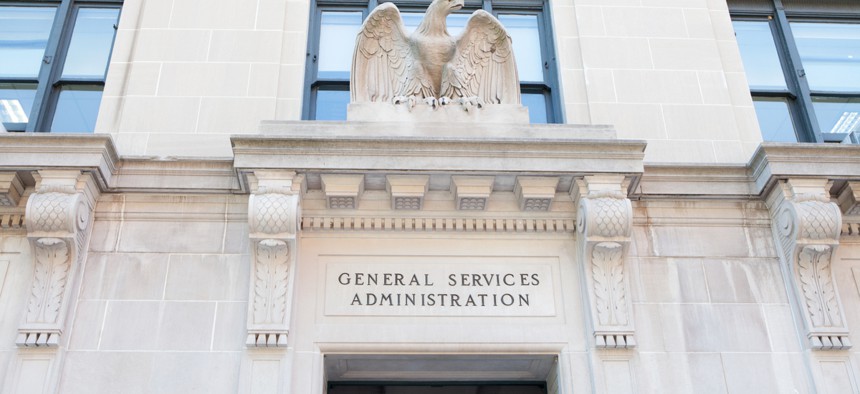GSA Outlines Multiple Award Schedule Consolidation Efforts

Mark Van Scyoc/Shutterstock
Officials have been rooting out inconsistencies and duplication in the Schedules program.
The General Services Administration is targeting cohesion and parity as it works to consolidate two dozen contract schedules into a single streamlined schedule, the director of the agency’s Multiple Awards Schedule Program Office said in Washington Wednesday.
Federal agencies use GSA’s $30+ billion Schedule program to purchase a range of more than 10 million products and services from compliant vendors. Stephanie Shutt, tasked with leading the transformation effort, offered fresh insight into the three phases of the consolidation project and the anticipated impacts that could accompany each.
“We saw that there were all these underlying issues related to duplication and inconsistency in this program,” Shutt said at an event held by ACT-IAC. “These issues were our core things to solve.”
The Multiple Award Schedule enables agencies to purchase a wide variety of commercial products, such as office supplies, food services, information technology solutions and others directly from vendors to avoid the potentially slow-moving process of traditional acquisitions. Last November, the agency unveiled plans to unite the 24 siloed schedules into one intuitive system. On Oct. 1, the agency completed the first phase of the integration and released the new single solicitation, where everything is in one place.
Phase one of the consolidation honed in on the creation of the new independent schedule, Shutt said. The contract is, by nature, large in scope. Shutt and her team tasked with the effort opted to organize it into categories that coincide with the Office of Management and Budget’s category management approach.
“They match the category management that OMB has established because we wanted to use something already out there,” she said. “We did not want to create something totally new.”
Shutt’s team also initially reviewed all of the Schedules. They addressed every term and condition to determine if any were no longer needed or needed to be redone. The agency did not introduce any new terms and conditions and removed duplicates if they caught more than one version of a specific contract clause. This was done in an effort to support agencies that have multiple contracts under the Schedules, which are each equipped with their own clauses that impact price adjustments or other components that could change from time to time.
“This is the stuff that will be made for consistent, so they’ll be just one version of that,” Shutt said.
Each of GSA’s Schedules was divided into more specific supply and service subcategories, referred to as Special Item Numbers, or SINs. During the first phase, Shutt’s team also downsized the number of duplicate or unnecessary SINs from approximately 900 to 320 in the new contract vehicle.
“So we did cut about 600 SINs from there because that is where that duplication was,” she said.
GSA also opted to create a new methodology and structure around the SINs, which was missing in the original MAS contracts. The new SINs structure is based on the North American Industry Classification System, or NAICS, a standard that many federal agencies already use. Shutt said phase two will begin over the course of the next business quarter and will primarily focus on ensuring that all existing contract holders complete a mass modification to update base terms and conditions, which will essentially move most contract holders to the new schedule.
Shutt also reassured vendors that the updates will not apply to negotiated elements of the contract—like performance periods or warranties—but will instead only impact the baseline terms and conditions. In November, the agency plans to put out an advanced notice regarding the mass modifications.
“I don’t have unicorn magic—and I need everyone to know this—I cannot magically merge all of your contracts into one special contract ... that’s not actually legal, so I cannot do it,” Shutt said. “What I can do is modify each contract individually, because this is what makes sure you guys have no disruptions with orders.”
During phase two, vendors will also see a migration of SINs and will have the opportunity to select SINs that were previously across separate Schedules.
Shutt and her team anticipate launching phase three in mid- to late-July of next year. She said the final phase will primarily support contractors who have multiple contracts with more than five years left to consolidate into one single contract under the new Schedule. “We are basically going to be asking you to tell us which contracts you need to keep and which you’d be willing to cancel and when that end date will be,” she said.
Shutt emphasized that vendors with only one contract under MAS, or with multiple contracts that will see completion in the next five years, will have done their diligence and completed the process by signing the “mass mod” in phase two. Phase three will solely impact contractors that have multiple contracts, particularly with more than five years left in business. Those vendors will receive emails and direct support from Shutt’s team about how to put together a plan to get down to one contract.
“Don’t overcomplicate it—if you feel that there’s an easier way to do this, it’s probably the best way,” Shutt said. “Don’t make it difficult just to make it difficult.”
In the last week that the legacy schedules were open, GSA received more offers than it typically sees in a month. Shutt said the team is now working through those to get them all awarded by January so that they’ll be ready for phase two.
And since opening the new streamlined solicitation on Oct. 1, Shutt said many have been putting the new system to use.
“Currently we’ve had about 200-something offers come in in the last week and a half,” she said.






